The Peach, the
Once upon a time in
Town House is not rural, nestled in comforting woods with neighborly owls and bears. It is found on a small town main street. Its environs are not impressive in themselves (no need for valet parking). The design of the restaurant, modern and sleek, would suit Park Slope Brooklyn. The restaurant seems plunked down: a gastronomic room that happens to be in Chilhowie, not particularly indigenous (although some ingredients are local).
Town House offers four menus: a short a la carte menu (one salad, three entrees, and a dessert); a four course prix fixe (two choices for each course); and a ten course tasting menu ($110). We selected the latter, and added two intriguing courses from the prix fixe, a blessing as these were among the best courses. We also had a mini-version of Charlie Berg’s excellent wine pairings (not staying in Chilhowie, value seemed the better part of valor). Although I do not cover wines, they were well-chosen and a creative match (only the Foggy Ridge Cider was from
I divide Chef Shields’ dishes into two: an ecstatic elegant minimalist style and the now-common modern cuisine, with busy plates covered with carefully shaped and processed ingredients. Chef Shields does busy food very well, but in a style that is often seen (this is also the style of Pastry Chef (Karen) Shields. What I will remember from here until hospice are the whispering dishes (Chilled Vegetable “Minestrone”; the
Soon there appeared a savory cookie of cocoa and black olive – a post-modern Oreo with Meyer lemon compote and parmesan cream. While I was impressed with the citrus cream filling, I found the cookie to be dry with a slightly oily mouthfeel. I should have revived my own oreo memories: removing the cookie and licking the cream.
It is dangerous to serve the best dish of the evening as the opening act. But at Town House this is surely the case. Chef Shields’ “Chilled Vegetable ‘Minestrone’” is an astonishing dish. It is a canonical creation, perhaps in the class of Keller’s Oysters and Pearls, or Michael Carlson’s Quail Egg Ravioli. Yet, Shields’ minestrone cannot truly be compared with this pair. Both are lush while Shields is restrained: Agnes Martin in a bowl. Like every goodly, godly stock the liquid is complex while appearing simple. This “soup” consists of 11 different (root) vegetables, rolled as small cylinders. We are served radish, beet, carrot, leek, and a chorus of others. Each has its color, creating a stunningly beautiful dish in a minimalist vein. Tasting each pipe, I realized that each had been cooked in its own herbal bath. The diner who ignores the vegetable consommé misses a
The second course seemed a scoop of orange sherbet sitting lonely on a plate: “The
The third dish – Soup of Cherries with “almond bread” (frozen almond milk), slow oven-roasted tomatoes, cucumber water, ginger, and sardines – was the most challenging dish of the evening, perhaps of the year. Some 35 years ago I was served a dish at Larry Forgione’s An American Place on
Scrambled egg mousse, a paean to breakfast, was fourth, and was another success. Although Heston Blumenthal of The Fat Duck places his breakfast dish – bacon and egg ice cream – at the end (perhaps to remind us how long we have been at table), this mousse is still an appetizer, and a lovely, quiet one. The scrambled egg mousse is served over smoked steelhead roe, sorghum, sweet spices, preserved ramp, and rye bread. I thought that the dish must contain bacon – it does not – but it captures most of the flavors that constitute bacon: sweetness, smokiness, saltiness. The texture is silky as one cuts into the mousse, hiding (as in the orange) complex deliciousness below.
Peekytoe Crab in Brown Butter and Lime with “caramelized onions,” banana, curry, and cider vinegar was in the style of modern cuisine’s symphonic dishes. Here was perhaps the most typical modern dish of the night. Chef Shields works with three basic ingredients: crab, banana, and onions, and then shapes them in various forms, textures, tastes, using multiple cooking processes. It was a virtuoso combination, but my concern with this presentation is that one never gets the same bite twice: there is not enough time to think about taste and texture before other tastes and textures intrude. Like many of the dishes the colors on the plate were shades of off-white.
The sixth dish was, for me, the most troubling dish, although one that I am reassessing. It was the dish for which I registered a complaint to Chef Shields; perhaps I spoke too rapidly. I was served a “Risotto” of Squid. Whenever one finds quotation marks on a menu, anxiety is about. This dish appeared a petite risotto, but one absent rice. The rice was squid cut as rice (surely a labor-intensive task). My first reaction was not happy. I would have preferred risotto sans quote marks: real Arborio rice is heavenly starch. In terms of sheer enjoyment I have not changed my stance. Yet, a week later I still think about the dish. The squid was deliberately chewy (some might say rubbery), not the meaty grilled calamari of Greek cuisine. By leaving out the rice, the dish had a creamy, aquatic purity. It was still my least favorite dish, but I can appreciate the choice. Perhaps it had something of the let-us-do-it-because-we-can sensibility, but it had a textual punch.
Now I received the first “extra” course: Corn and Crispy Pig Tail with basil-infused buttermilk, toffee, popcorn, and cocoa nibs. Like the crab this was a dish that is very much in the register of modern cuisine: a focus on the possibilities of corn with a butt wag to Fergus Henderson’s snout-to-literally-tail cuisine. This presentation brought to mind a stalk of corn, and is stunning as this style gets. The textures – gelatinous, smooth, stringy, chewy, meaty, liquid – were showy. Here was something other than a mish-mash, but a set of ideas. Corn and Tail is dramatically different from the quieter dishes (Shields works with several distinctive cooking styles), but is a vivid composition.
The foie gras royale, confit and crisp chicken skin (covered with a patch of fresh berries – a batch of fresh perries?) was easily the most vibrant presentation of the evening (my photograph shamefully lacks justice). What is not to like about duck liver and blackberries? Nothing, of course. To say that it was nothing special seems to demean the dish, but only in contrast. It is a dish that makes diners happy in three-star cuisine.
And then naked came the peach (“A minimal preparation of peach roasted in beef fat and chanterelle mushroom bouillon”), a second extra dish. If the minestrone had been out of stock, the little peach would have stolen my heart. I would be raving about this roast slice of fruit. If peach were filet how would it taste? Shields is a consummate consommé master. This was almost as perfect a two-bite dish as could imagine, so beefy, so woodsy, so filled with the orchard. Astonishing!
The entrée was Lamb Cooked in Ash with Smoked Eggplant Cream Puree, Miso, Black Garlic, Bonito, and pulverized potato starch. Shields serve a meat dish that is textbook, so filled with paper-like ingredients it was. Much was thin, wrinkled, and crackly, the floor of an academic office. I was stunned in its play with textures and its reflection of ash. Perhaps its bustle was overshadowed by the peach, but I cannot deny my pleasure throughout.
The two desserts, created by Karen Urie Shields, formerly of
The second dessert was Blueberries and Lychee with Peony Sorbet (wonderful), goat yogurt, coriander berries (very distinctive), and crispy milk skin (the Shields could open a culinary paper mill). I love lychee and so I was pleased with the dessert, but it revealed the limits of modern cuisine, perhaps it was too impressive in its fireworks. If one preparation is astonishing, sometimes having five or six on the plate makes amazement routine.
My unasked-for advice for a brilliant ending is to create a dessert-equivalent of the minestrone. Choose eleven fruits, shape them beautifully, serve with a light, off-sweet consommé, and remind us again just how simple food can be complex. Or, if not, a nugget of veal served as a nectarine.
It took three hours to arrive at Town House and three hours to dine and three hours to return home. Three hours of expectation, three hours of reminiscences, and three hours of pure joy.
Town House
276-646-8787
The restaurant has an associated guest house for those wishing a full wine tasting.


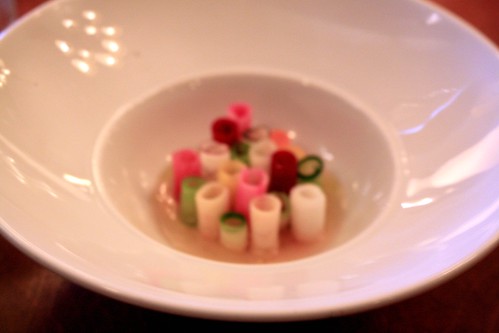
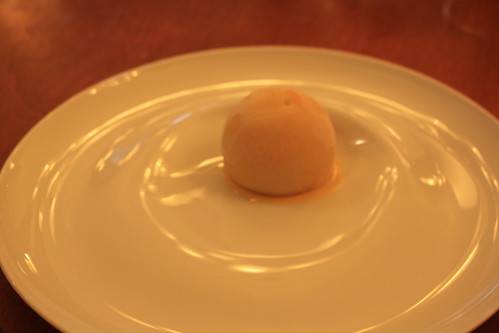
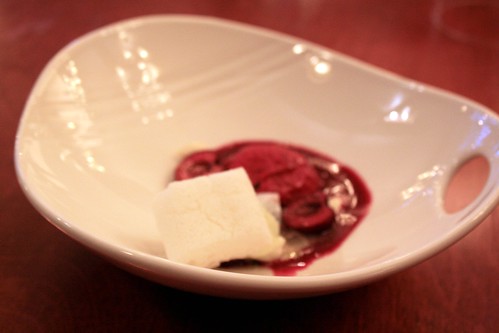



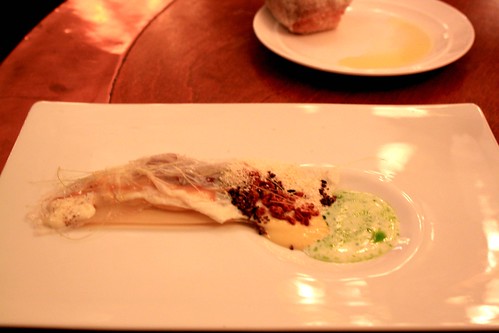

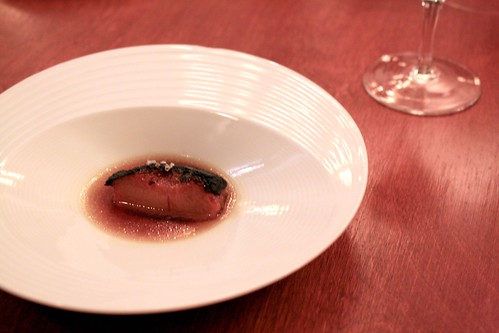
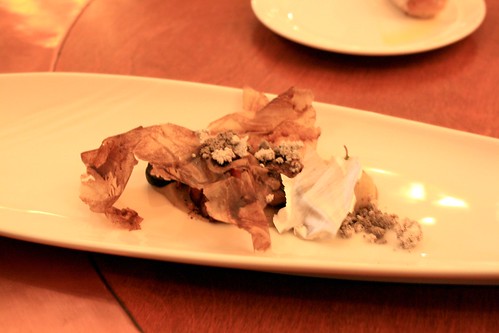
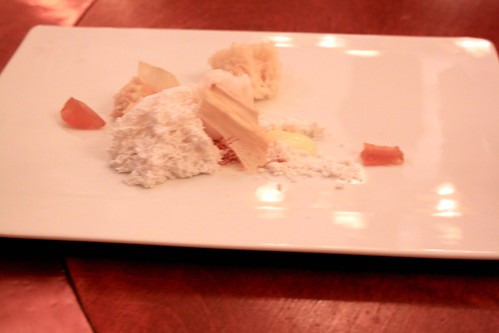


No comments:
Post a Comment